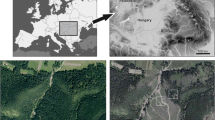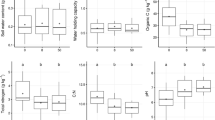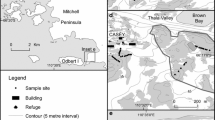Abstract
Dispersal of soil organisms is crucial for their spatial distribution and adaptation to the prevailing conditions of the Antarctic Dry Valleys. This study investigated the possibility of wind dispersal of soil invertebrates within the dry valleys. Soil invertebrates were evaluated in (1) pockets of transported sediments to lake ice and glacier surfaces, (2) wind-transported dust particles in collection pans (Bundt pans) 100 cm above the soil surface, and (3) sediments transported closer to the surface (<50 cm) and collected in open top chambers (OTCs). Invertebrates were extracted and identified. Nematodes were identified to species and classified according to life stage and sex. Three species of nematodes were recovered and Scottnema lindsayae was the most dominant. There were more juveniles (∼71%) in the transported sediments than adults (29%). Tardigrades and rotifers were more abundant in sediments on lake and glacier surfaces while nematodes were more abundant in the dry sediment collections of Bundt pans and OTCs. The abundance of immobile (dead) nematodes in the Bundt pans and OTCs was three times greater than active (live) nematodes. Anhydrobiosis constitutes a survival mechanism that allows wind dispersal of nematodes in the McMurdo Dry Valleys. Our results show that soil invertebrates are dispersed by wind in the Dry Valleys and are viable in ice communities on lake surfaces and glaciers.




Similar content being viewed by others
References
Bamforth SS, Wall DH, Virginia RA (2005) Distribution and diversity of soil protozoa in the McMurdo Dry Valleys of Antarctica. Polar Biol (in press)
Barrett GW, Dyne GMV, Odum EP (1976) Stress ecology. Bioscience 26:192–194
Barrett JE, Virginia RA, Wall DH, Parsons AN, Powers LE, Burkins MB (2004) Variation in biogeochemistry and soil biodiversity across spatial scales in polar desert ecosystem. Ecology 85:3105–3118
Baujard P, Martiny B (1994) Transport of nematodes by wind in the peanut cropping area of Senegal, West Africa. Fund Appl Nematol 17:543–550
Benninghoff WS, Benninghoff AS (1985) Wind transport of electrostatically charged particles and minute organisms in Anarctica. In: Siegfried WR, Condy PR, Laws RM (eds) Antarctic nutrient cycles and food webs. Springer, Berlin Heidelberg New York, pp 592–596
Carroll JJ, Viglierchio DR (1981) On the transport of nematodes by the wind. J Nematol 13:476–483
Convey P (1996) The influence of environmental characteristics on life history attributes of Antarctic terrestrial biota. Biol Rev 71:191–225
Coulson S, Hodkinson ID, Webb NR (2003) Aerial dispersal of invertebrates over a high-Arctic glacier foreland: Midtre Lovénbreen, Svalbard. Polar Biol 26:530–537
Courtright EM, Wall DH, Virginia RA, Frisse LM, Vilda JT, Thomas WK (2000) Nuclear and mitochondrial DNA sequence diversity in the Antarctic nematode Scottnema lindsayae. J Nematol 32:143–153
Courtright EM, Wall DH, Virginia RA (2001) Determining habitat suitability in an extreme environment: the McMurdo Dry Valleys, Antarctica. Antarct Sci 13:9–17
Crowe JH, Clegg JS (1978) Dry biological systems. Academic, New York
Crowe JH, Madin KAC (1975) Anhydriobiosis in nematodes: evaporative water loss and survival. J Exp Zool 193:323–334
Demeure YDW, Freckman DW (1981) Recent advances in the study of anhydrobiotic nematodes. In: Zuckerman BM, Rhode RA (eds) Plant parasitic nematodes. Academic, London, pp 205–226
De Rooij-van der Goes, Pcem PBAM, van der Putten WH (1998) Vertical migration of nematodes and soil-borne fungi to developing roots of Ammophila arenaria (L.) link after sand accretion. Appl Soil Ecol 10:1–10
Doran PT, McKay CP, Clow GD, Dana GL, Fountain AG, Nylen T, Lyons WB (2002) Valley floor climate observations from the McMurdo dry valleys, Antarctica. J Geophys Res 107:4772
Ellis-Evans JC, Walton DWH (1990) The process of colonization in Antarctic terrestrial and freshwater ecosystems. In: Proceedings of the NIPR symposium on polar biology, Tokyo, Japan, pp 151–163
Fountain AG, Lyons WB, Burkins MB, Dana GL, Doran PT, Lewis KJ, McKnight DM, Moorehead DL, Parsons AN, Priscu JC, Wall DH, Wharton JR, Virginia RA (1999) Physical controls on the Taylor Valley ecosystem, Antarctica. Bioscience 49:961–971
Freckman DW (1978) Ecology of anhydrobiotic soil nematodes. Dry biological systems. Academic, New York, pp 345–357
Freckman DW, Virginia RA (1993) Extraction of nematodes from the Antarctic soils. Polar Biol 13:483–487
Freckman DW, Virginia RA (1997) Low-diversity Antarctic soil nematode communities: distribution and response to disturbance. Ecology 78:363–369
Freckman DW, Virginia RA (1998) Soil biodiversity and community structure in the McMurdo Dry Valleys, Antarctica. In: Priscu JC (ed) Ecosystem dynamics in a Polar Desert: The McMurdo Dry Valleys, Antarctica. America Geophysical Union, Washington DC, pp 323–335
Freckman DW, Mankau R, Ferris H (1975) Nematode community structure in desert soils: nematode recovery. J Nematol 7:346–346
Gressitt JL, Leech RE, O’Brien CW, (1960). Trapping of air-borne insects in the Antarctic area. Pac Insects 2:245–250
Hogg ID, Stevens MI (2002) Soil fauna of Antarctic coastal landscape. In: Beyer L, Bolter M (eds) Geoecology of Antarctic ice-free coastal landscapes. ecological studies 154:265–280
Janiec K (1996) Short distance wind transport of microfauna in maritime Antarctic (King George Island, South Shetland Islands). Pol Polar Res 17: 203–211
JMP (2002) The statistical discovery software. SAS Institute Inc., NC
Lancaster N (2002) Flux of Aeolian sediment in the McMurdo Dry Valleys, Antarctica: a preliminary assessment. J Arct Antarct Alp Res 34:318–323
Lyons WB, Welch KA, Carey AE, Wall DH, Virginia RA, Fountain AG, Doran PT, Csanthó BM, Tremper CM (2005) Groundwater seeps in Taylor Valleys Antarctica: an example of a subsurface melt event (in press)
Marion GM, Henry GHR, Freckman DW, Johnstone J, Jones G, Jones MH, Lévesque E, Molau U, Mϕlgaard P, Parsons AN, Svoboda J, Virginia RA (1997) Open-top designs for manipulating field temperature in high-latitude ecosystems. Global Change Biol 3:20–32
Marshall DJ, Pugh PJA (1996) Origin of the inland Acari of continental Antarctica with particular reference to Dronning Maud Land. Zool J Linn Soc 118:101–118
McKnight DM, Niyogi DK, Alger AS, Bomblies A, Conovitz PA (1999) Dry Valley streams in Antarctica: ecosystems waiting for water. Bioscience 49:985–995
Nylen TH, Fountain AG (2004) Climatology of katabatic winds in the McMurdo dry valleys, southern Victoria Land, Antarctica. J Geophys Res 109:D03114
Orr CC, Newton OH (1971) Distribution of nematodes by wind. Plant Dis 55:61–63
Porazinska DL, Wall DH (2002) Population age structure of nematodes n the Antarctic Dry Valleys: perspectives on time, space and habitat suitability. Arct Antarct Alp Res 34:159–168
Porazinska DL, Fountain AG, Nylen T, Tranter M, Virginia RA, Wall DH (2004) The biodiversity and biogeochemistry of Cryoconite holes from McMurdo Dry Valley Glaciers, Antarctic. Arct Antarct Alp Res 36:84–91
Powers LE, Freckman DW, Virginia RA (1995) Spatial distribution of nematodes in polar desert soils of Antarctica. Polar Biol 15:325–333
Powers LE, Ho M, Freckman DW, Virginia RA (1998) Distribution, community structure, and microhabitats of soil invertebrates along an elevational gradient in Taylor Valley, Antarctica. Arct Alp Res 30:133–141
Priscu JC, Fritsen CH, Adams EE, Giovannoni SJ, Paerl J, McKay CP, Doran PT, Gordon DA, Lanoil BD, Pinckney JL (1998) Perennial Antarctic lake ice: an oasis for life in a Polar Desert. Science 280:2095–2098
Prot JC, VanGundy SD (1981a) Influence of photoperiod and temperature on migrations of Meloidogyne juveniles. J Nematol 13:217–220
Prot JC, VanGundy SD (1981b) Effect of soil texture and clay component on migration of Meloidogyne incognita Second-stage juvenile. J Nematol 13:213–217
Ran N, Katul GG, Horn HS, Thomas MS, Oren R, Avissar R, Pacala SW, Levin SA (2002) Mechanisms of long-distance dispersal of seeds by wind. Nature 418:409–413
Schill RO, Steinbrück GHB, Köhler HR (2004) Stress gene (hsp70) sequences and quantitative expression in Milnesium tardigradum (Tardigrada) during active and cryptobiotic stages. J Exp Biol 207:1605–1611
Shapiro DI, Berry EC, Lewis LC (1993) Interaction between nematodes and earthworms—enhanced dispersal of Steinernema-Carpocapsae. J Nematol 25:189–192
Steiner WA (1996) Dispersal and host-finding ability of entomopathogenic nematodes at low temperatures. Nematologica 42:243–261
Treonis AM, Wall DH (2005) Soil nematodes and desiccation survival in the extreme arid environment of the Antarctic Dry Valleys (in press)
Treonis AM, Wall DH, Virginia RA (1999) Invertebrate biodiversity in Antarctic dry valley soils and sediments. Ecosystems 2:482–492
Treonis AM, Wall DH, Virginia RA (2000) The use of anhydrobiosis by soil nematodes in the Antarctic Dry Valleys. Funct Ecol 14:460–467
Virginia RA, Wall DH (1999) How soils structure communities in the Antarctic Dry Valleys. Bioscience 49:973–983
Wall DH, Virginia RA (1999) Controls on soil biodiversity: insights from extreme environments. Appl Soil Ecol 13:137–150
Walton DWH (1990) Colonisation of terrestrial habitats. Organisms, opportunity and occurrence. In: Kerry KR, Hempel GK (eds) Antarctic Ecosystem: ecological changes and conservation. Springer, Berlin Heidelberg New York, pp 51–60
Weicht TR, Moorhead DL (2004) The impact of anhydrobiosis on the persistence of Scottnema lindsayae (Nematode): a modeling analysis of population stability thresholds. Polar Biol 27:507–512
Zar JH (1998) Biostatistical analysis Upper Saddle Rover. Prentice Hall, NJ
Acknowledgements
The authors appreciate the assistance from the staff of the Crary Laboratory, at McMurdo Station, PHI Helicopters, Rae Spain and the Soil Ecology team at NREL, Colorado State University. National Science Foundation grant OPP 98-10219 to Diana Wall through the McMurdo Long Term Ecological Research provided funding for this project. Thanks to Andy Parsons, Melody Burkins, Amy Treonis, Steve Blecker, and Lily Hoffman who were involved in various stages of the study.
Author information
Authors and Affiliations
Corresponding author
Rights and permissions
About this article
Cite this article
Nkem, J.N., Wall, D.H., Virginia, R.A. et al. Wind dispersal of soil invertebrates in the McMurdo Dry Valleys, Antarctica. Polar Biol 29, 346–352 (2006). https://doi.org/10.1007/s00300-005-0061-x
Received:
Revised:
Accepted:
Published:
Issue Date:
DOI: https://doi.org/10.1007/s00300-005-0061-x




